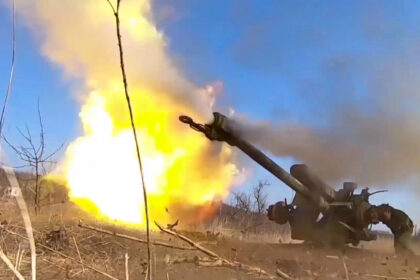**China Unveils New Graphite Bomb with Widespread Power Outage Capability**
In a move that has sparked concerns about its military capabilities, China’s state TV broadcaster CCTV has revealed details of a new “graphite bomb” that can cause a complete loss of electricity across an area of 10,000 square meters. The video, which was released on June 29 by the South China Morning Post, shows a missile being launched from a ground-based launcher and then flying to a target where it releases 90 small submunitions.
These submunitions then bounce on the ground before exploding amid a mock-up of an electrical substation. The video then shows electrical equipment malfunctioning, highlighting the potential impact of such a weapon on power supplies.
**How Does a Graphite Bomb Work?**
A graphite bomb works by releasing a dense cloud of tiny graphite particles over a target area. As graphite is an excellent conductor of electricity, any power lines or electrical equipment in the target area will be short-circuited, leading to widespread power outages. While such a weapon may not be lethal, it can cause significant disruptions and casualties among a civilian population.
**A Non-Lethal but Potentially Devastating Weapon**
Graphite bombs have been around for decades and are known to have been used by Western nations on two occasions – during the Kosovo war in 1999 and the Gulf War in Iraq in 1991. In both cases, the intention was to minimize civilian casualties while targeting military infrastructure.
However, reports from these incidents highlighted the adverse effects of such attacks on public health and healthcare systems. A report by the International Physicians for the Prevention of Nuclear War concluded that attacking electrical generating plants and other civilian infrastructures is a “war on public health.”
**China’s Graphite Bomb: A New Technology?**
While China’s new graphite bomb appears to be similar in concept, there are differences in how it can be deployed compared to Western versions. The video released by CCTV shows submunitions that self-detonate to create a cloud of graphite particles.
It is worth noting that South Korea also developed its own graphite bomb and was ready to deploy it against North Korea in 2017, highlighting the potential for other countries to develop similar capabilities.
**The Implications**
China’s unveiling of this new graphite bomb comes amid heightened global tensions, particularly regarding a potential Chinese invasion of Taiwan. The country has also been a key ally to Russia during its full-scale war with Ukraine, helping Moscow evade Western sanctions and fueling the Russian defense industry with dual-use goods.
In light of these developments, the implications of China’s new graphite bomb capabilities are far-reaching and potentially devastating. While it may not be lethal in itself, the power outages caused by such a weapon can have severe consequences for civilian populations.
**A Word of Caution**
As experts like Chris York, news operations editor at the Kyiv Independent, remind us, even non-lethal attacks on civilian infrastructure can have significant and long-lasting impacts on public health and healthcare systems. As tensions escalate around the world, it is crucial to consider the potential consequences of such technologies being used.
**The Bottom Line**
China’s new graphite bomb has sparked concerns about its military capabilities and the potential implications for global security. While it may not be a game-changer in itself, it highlights the need for countries to invest in defense strategies that protect both civilians and critical infrastructure from the devastating effects of such attacks.
Read More @ kyivindependent.com












